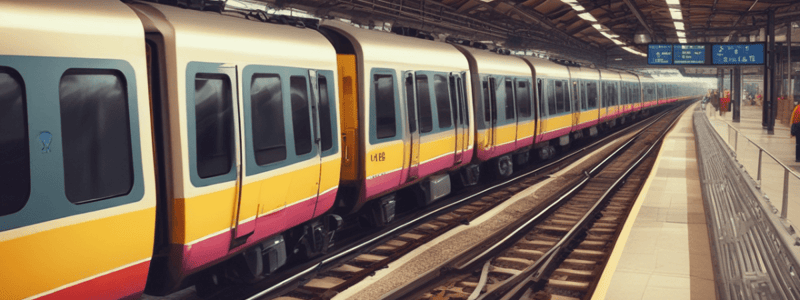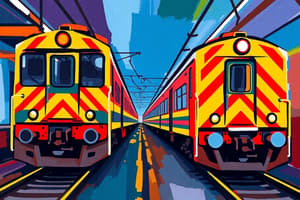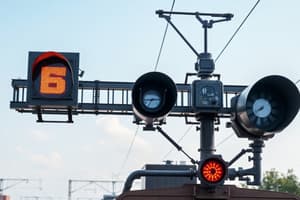Podcast
Questions and Answers
What is the numbering scheme for Annexures in a Chapter?
What is the numbering scheme for Annexures in a Chapter?
- Annexure: A19-1, where A stands for Annexure, 19 stands for Chapter number and 1 indicates that it is the first Annexure for that Chapter
- Annexure: 19-A1, where 19 stands for Chapter number, A stands for Annexure and 1 indicates that it is the first Annexure for that Chapter (correct)
- Annexure: C1, where C stands for Chapter number, 1 indicates that it is the first Annexure for that Chapter
- Annexure: 19-1, where 19 stands for Chapter number, 1 indicates that it is the first Annexure for that Chapter
Where are Maintenance Schedules located?
Where are Maintenance Schedules located?
- Appendix II
- Appendix I (correct)
- Chapter 21
- Annexure
What is the numbering scheme for drawings in Appendix-II?
What is the numbering scheme for drawings in Appendix-II?
- Drg no: 1-D3, where 1 stands for Chapter Number, D stands for Drawing and 3 stands for third drawing for that chapter
- Drg no: 13-D3, where 13 stands for Chapter Number, D stands for Drawing and 3 stands for third drawing for that chapter
- Drg no: 21-D3, where 21 stands for Chapter Number, D stands for Drawing and 3 stands for third drawing for that chapter
- Drg no: 19-D3, where 19 stands for Chapter Number, D stands for Drawing and 3 stands for third drawing for that chapter (correct)
What is the purpose of Annexure: 13-MS2?
What is the purpose of Annexure: 13-MS2?
What is the limitation of adopting certain stipulations?
What is the limitation of adopting certain stipulations?
What is the purpose of Appendix I?
What is the purpose of Appendix I?
What is the limitation of using the information in Signal Engineering Manual?
What is the limitation of using the information in Signal Engineering Manual?
What is the purpose of General Annexures?
What is the purpose of General Annexures?
Which section of Chapter 14 deals with the installation of LC Gates?
Which section of Chapter 14 deals with the installation of LC Gates?
Which chapter of the IRSEM manual deals with ATP, ETCS, TPWS, IRATP, and TMS?
Which chapter of the IRSEM manual deals with ATP, ETCS, TPWS, IRATP, and TMS?
What is the title of Annexure 13-A1?
What is the title of Annexure 13-A1?
Which section of Chapter 15 deals with the maintenance of cables?
Which section of Chapter 15 deals with the maintenance of cables?
What is the title of Chapter 16?
What is the title of Chapter 16?
What is the title of Annexure 12-A3?
What is the title of Annexure 12-A3?
Which section of Chapter 13 deals with IRATP – Train Collision Avoidance System (TCAS)?
Which section of Chapter 13 deals with IRATP – Train Collision Avoidance System (TCAS)?
What is the title of Annexure 12-A2?
What is the title of Annexure 12-A2?
What is the primary responsibility of a Signal and Telecommunication Engineer in terms of staff management?
What is the primary responsibility of a Signal and Telecommunication Engineer in terms of staff management?
What is the primary responsibility of the Signal and Telecommunication Engineer incharge of Construction?
What is the primary responsibility of the Signal and Telecommunication Engineer incharge of Construction?
What is the percentage of installations that a Sr DSTE is responsible for inspecting in a year?
What is the percentage of installations that a Sr DSTE is responsible for inspecting in a year?
What is the purpose of the 'Transfer of Charge' statement?
What is the purpose of the 'Transfer of Charge' statement?
What is the purpose of issuing traffic notices & Programme of Pre-NI and NI?
What is the purpose of issuing traffic notices & Programme of Pre-NI and NI?
What is the frequency of submitting progress reports to Headquarters?
What is the frequency of submitting progress reports to Headquarters?
Who is responsible for preparing the 'Transfer of Charge' statement?
Who is responsible for preparing the 'Transfer of Charge' statement?
What is the purpose of periodical verification of materials at site?
What is the purpose of periodical verification of materials at site?
What is the primary responsibility of a Signal and Telecommunication Engineer in terms of maintenance?
What is the primary responsibility of a Signal and Telecommunication Engineer in terms of maintenance?
What is the purpose of the joint inspection of works or important sections?
What is the purpose of the joint inspection of works or important sections?
Who is responsible for executing certain specific works?
Who is responsible for executing certain specific works?
What is the purpose of submitting a Safety Certificate to Commissioner of Railway Safety/PCSTE?
What is the purpose of submitting a Safety Certificate to Commissioner of Railway Safety/PCSTE?
Who is responsible for deciding the percentage of installations to be inspected by a Sr DSTE?
Who is responsible for deciding the percentage of installations to be inspected by a Sr DSTE?
What is the purpose of the special maintenance schedules for SSE(Signal)/Incharge, Sectional SSE/JE (Signal) and Technicians?
What is the purpose of the special maintenance schedules for SSE(Signal)/Incharge, Sectional SSE/JE (Signal) and Technicians?
Who is responsible for top-initialing the blank muster sheets?
Who is responsible for top-initialing the blank muster sheets?
What is the primary purpose of inspecting and initialing the muster sheets?
What is the primary purpose of inspecting and initialing the muster sheets?
What is the frequency of submitting periodical returns as per the standing instructions?
What is the frequency of submitting periodical returns as per the standing instructions?
What is the purpose of preparing a handing over charge statement when relinquishing charge of a section?
What is the purpose of preparing a handing over charge statement when relinquishing charge of a section?
What information should be included in the handing over charge statement?
What information should be included in the handing over charge statement?
What is the responsibility of the SSE(Signal)/Incharge regarding the maintenance of office records?
What is the responsibility of the SSE(Signal)/Incharge regarding the maintenance of office records?
What should be done with the muster sheets at the end of each wage period?
What should be done with the muster sheets at the end of each wage period?
How should the time of inspection and the number of staff present be recorded in the muster sheet?
How should the time of inspection and the number of staff present be recorded in the muster sheet?
Flashcards are hidden until you start studying
Study Notes
Chapter 13: ATP, ETCS, TPWS, IRATP (TCAS) & TMS
- ATP, ETCS, TPWS, IRATP (TCAS), and TMS are discussed in Chapter 13
- Section 1 covers general requirements
- Section 2 discusses European Train Control Systems (ETCS) and Train Protection and Warning Systems (TPWS)
- Section 3 focuses on IRATP – Train Collision Avoidance System (TCAS)
- Section 4 covers Traffic Management System (TMS)
- Annexure 13-A1 provides breaking distance calculations for TCAS
Chapter 14: LC Gates
- Chapter 14 is about Level Crossing (LC) Gates
- Section 1 discusses general information about LC Gates
- Section 2 covers installation of LC Gates
- Section 3 focuses on maintenance of LC Gates
- Annexure 14-A1 provides safety measures to be provided at Level Crossings
Chapter 15: Cables
- Chapter 15 is about cables
- Section 1 covers general information about cables
- Section 2 discusses paying out, trenching, and laying of cables
- Section 3 focuses on cable laying in RE areas
- Section 4 covers insulation resistance testing of signal cables
- Section 5 discusses maintenance of cables
Chapter 16: Power Supply Systems for Signalling Installations
- Chapter 16 discusses power supply systems for signalling installations
- Section 1 covers general information about power supply systems
Annexure and Drawing Numbering
- Annexures are numbered as Annexure: 19-A2, where 19 is the Chapter number, A is for Annexure, and 2 indicates that it is the second Annexure for that Chapter
- Drawings are given in Appendix-II, with numbering scheme as Drg no: 19-D3, where 19 is the Chapter number, D stands for Drawing, and 3 stands for the third drawing for that chapter
Transfer of Charge
- Instructions on "Transfer of Charge" are contained in Chapter I of Indian Railway Code for Engineering Department
- Senior Divisional Signal and Telecommunication Engineer/Dy.Chief Signal and Telecommunication Engineers shall carry out joint inspection of works or important sections as necessary
- The "Transfer of Charge" statement shall be prepared in adequate number of copies, signed by both, and one copy sent to the Principal Chief Signal and Telecommunication Engineer
Studying That Suits You
Use AI to generate personalized quizzes and flashcards to suit your learning preferences.




